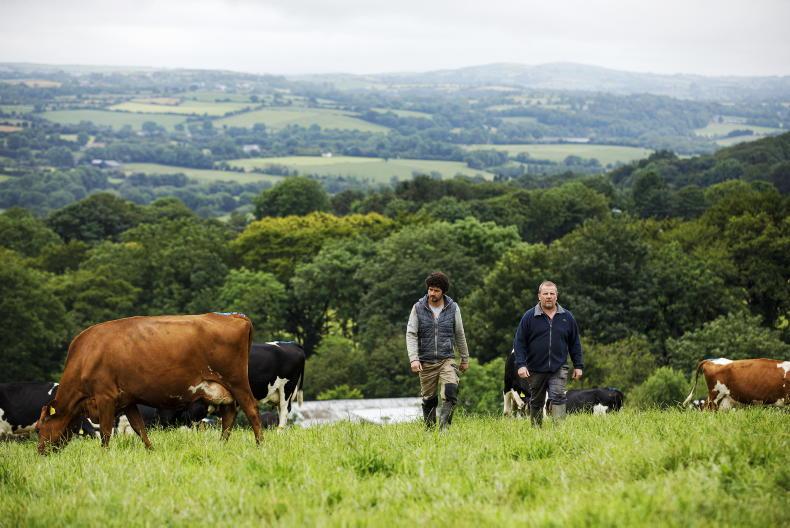Last week’s announcement by Science Foundation Ireland that is it awarding the Farm Zero C project its future innovator award, with a prize fund of €2m, was a positive dairy-related news story at a time when positive news stories are scarce.
The Farm Zero C project is a collaboration between Carbery, UCD and BioOrbic, which is part of Science Foundation Ireland. The project aims to make the Shinagh farm carbon-neutral by 2027 and to roll out the lessons learned to over 5,000 other dairy farmers.
Ten years ago, the Shinagh farm was established as a demonstration dairy farm for the west Cork region.
The land is owned by the four west Cork co-ops through their ownership of Shinagh Estates.
Teagasc has and will continue to be involved in the running of the farm as it transitions to zero carbon.
It’s fair to say that for the last decade, the main focus on the farm has been on productivity and profit.
Under the stewardship of farm manager Kevin Ahern and Teagasc adviser John McNamara, performance has been excellent. Last year, the farm delivered a common profit of €2,525/ha from a herd of 239 cows stocked at 2.57 cows/ha overall, delivering 439kgMS/cow from 594kg meal/cow.
I’ve always said that a farm cannot be green if it’s in the red financially|
Enda Buckley, head of sustainability at Carbery, is leading the project from the co-op side.
He says that they will still have one eye on profit, even as they transition towards net zero carbon emissions.
“We’ll be keeping one eye on profit and the bottom line. I’ve always said that a farm cannot be green if it’s in the red financially.
“Our objective is to demonstrate what a real farm can do to become carbon-neutral. It has never even come up for discussion to reduce cow numbers or become less productive,” Enda says.
Professor Kieran O’Connor is leading the project from the UCD side.
Between them, they say there are three big areas that the team will be focusing on to achieve the greatest reduction in greenhouse gas emissions. These three big ticket items are:
1 Nitrogen use efficiency: chemical nitrogen use is back 20% already this year and the plan is to reduce it to between 120kg N/ha and 140kg N/ha over the coming years. Only protected urea will be used. This reduction in chemical nitrogen will be achieved through using low-emission slurry spreading, establishing high-clover and multispecies swards and using biofertilisers.
2 Feed additives: these will be used to reduce methane emissions from the cows. “There are multiple studies ongoing looking at additives to reduce methane emissions and the early results show a range of reductions from zero to 90%. It is our intention to pick the technology that works the best and then employ that on the farm,” Enda explains.
3 Carbon sequestration: this is currently not being routinely measured or accounted for on Irish farms. Grass, crops, trees and hedgerows can sequester carbon from the atmosphere and store it in the soil in the form of soil carbon. The team at Shinagh will be using deep soil samples and satellite imagery to measure carbon sequestration over time. Even without sequestration being accounted for, they say they will get 70% to 80% of the way to carbon neutrality.
A raft of other measures are proposed to increase the biodiversity on the farm, including sowing more multispecies swards.
We have a plan in place to increase this and it’s mostly simple stuff, like not using pesticides
“We’re aiming for 10% of the farm to be high-quality habitat area. Over the last year we have undertaken extensive habitat mapping and we’re already at 8.5% habitat area, so we’re nearly there as it is.
“We have a plan in place to increase this and it’s mostly simple stuff, like not using pesticides, managing hedgerows and roadway verges, etc.
“All of these things are feeding into our natural capital and will help towards achieving climate neutrality,” Kevin says.
Other measures such as using renewable energy and biogas will also be employed.
The Shinagh farm aims to be carbon-neutral by 2027
The farms in the new Teagasc-Carbery joint programme will be used as replicator farms for the project. Results from the project will be published regularly and the farm will be open to farmers and environmentalists for training and upskilling.
What is zero carbon? Greenhouse gas emissions are usually expressed in carbon equivalents. The Shinagh farm aims to be carbon-neutral by 2027, meaning the emissions it releases from farming activity will be offset by the carbon it is taking in through sequestration. In the long term, the researchers expect that the farm will become a carbon sink, meaning it will be sequestering more carbon than it emits and earning money for this.






 This is a subscriber-only article
This is a subscriber-only article









SHARING OPTIONS: